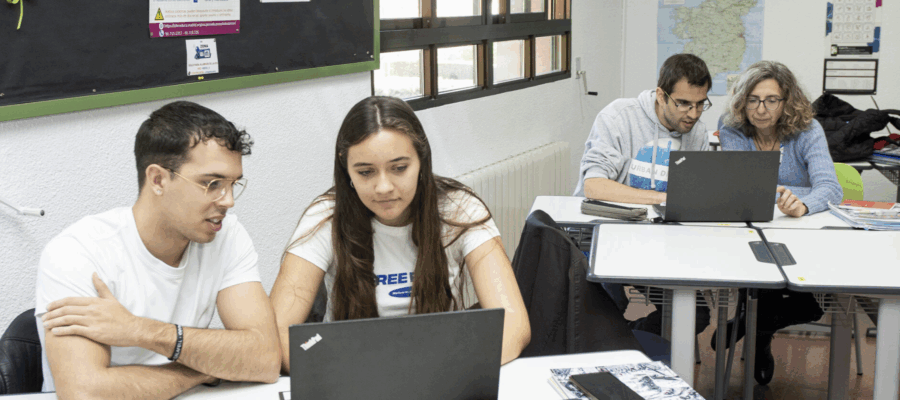Don’t press play (yet!)
Using authentic video to develop communication skills? Don’t press play until you do three things!
When I started teaching in the 1990s, I believed in the power of authentic video — news reports, documentaries, TV shows, films — to engage learners and bring real English into the classroom.
In lessons, I’d press play, then after a bit of watching, we’d discuss it. Unfortunately, students’ response was often frustration at how little they understood, even on a second or third viewing. There were significant challenges: idioms, complex grammar, fast speech, unfamiliar content. And it wasn’t clear how this could improve their English.
So I began reserving the “real stuff” for advanced learners and used graded material at lower levels. This was OK, but learners often felt the material was oversimplified. Graded listening material is often easier than exam listening. And students asked, “Why can I understand English in the classroom, but not in films?”
I had a lot to learn.
Fast forward twenty years. I was asked to develop lessons using TED Talks. Now, I understand that successful teaching isn’t about the level of the input, but about the level of the lesson and supporting learners’ communication skills development.
How can we support learners using authentic video?
Here are three ideas, with TED Talks as examples:
Support listening
When you hit play, students may not understand what they hear.
To help them, you can:
- explain before watching what the video is about. Discuss the main ideas and key language. You can give learners most of the message so when they watch, they are confirming what they already understand.
- show the video with the sound off and talk about what can be understood visually — the speaker’s body language, props they use on stage, slides or other visuals they use.
- encourage learners to be comfortable with incomplete understanding. The goal isn’t to understand every word, but to understand some of the ideas.
In her talk An Olympic Champion’s Mindset for Overcoming Fear, Allyson Felix speaks naturally and uses some high-level words. Prepare for listening by asking learners to focus on one aspect of the language — for example, discourse markers.
These words and phrases indicate what kind of information is going to follow. The phrase a few years ago may mean the speaker is going to tell a story. Unfortunately introduces a sad or negative fact.
Learners can listen for one feature before they begin to work out the main ideas of the talk.
Support speaking skills
A TED Talk is a carefully prepared presentation, demonstrating excellent speaking techniques – super useful for helping learners develop presentation skills. But a lot of those skills are useful in any speaking context: being aware of pace, emphasizing main points with stress, using open body language.
You support learners when you:
- help them notice how pronunciation makes certain speakers easy to understand.
- get them to think about helpful ways of expressing ideas for listeners.
- consider the voice or personality of a speaker and what makes them seem more approachable.
- have them rehearse the same language repeatedly. This is great for memorizing chunks of language and for working on clear pronunciation.
In his TED Talk How To Build With Clay … And Community, Diébédo Francis Kéré exemplifies the power of tone of voice.
We can draw these pointers from his talk:
✔ Use a light-hearted and friendly tone to create a relaxed atmosphere.
✔ Try speaking more deliberately or slowly to emphasize main points.
✔ Use an excited tone to show enthusiasm for what you’re saying.
✖ Don’t change your voice so much that it sounds artificial.
The overall message? Be natural, be yourself. You don’t have to speak perfect “native-like” English; you just need to apply speaking techniques that make you understandable.
Support critical thinking skills
Clear communication goes hand in hand with clear thinking. In addition to understanding the words they hear, learners need to think about how a message is delivered, what’s meant beyond what’s spoken, and whether it’s true or not.
You will support learners’ critical thinking when you help them:
- evaluate arguments and consider pros and cons.
- analyze a speaker’s purpose, technique, and examples.
- assess evidence.
In his talk, What a Living Whale is Worth―and Why the Economy Should Protect Nature, Ralph Chami advocates addressing climate change by integrating the natural capital of plants and animals into the traditional economic system.
One way to evaluate whether an idea is feasible is to apply it to different situations. This often reveals obstacles, problems, or questions that need to be addressed.
Ask learners to consider how Chami’s idea can be applied to other aspects of life. How might some of the things below provide an economic value to society?
- having clean air to breathe
- parents staying at home to raise their children
- activities that celebrate a country’s cultural heritage
Bringing these questions to the table will help students understand the TED Talk more deeply.
If you’d like to try teaching with TED Talks, find one you like, and before you press play, be sure you’re ready to support your learners’ listening, speaking, and critical thinking using the talk.
If you’re not sure which TED Talk to use, start with the ones suggested above.
Now you can press play. Good luck!
For more advice on using authentic video to develop students’ communication skills, watch the recording of “Developing Confidence in Communication with Keynote, Second Edition,” co-presented by Keynote authors Lewis Lansford and Paul Dummett.



What strategies can help students overcome frustration and improve comprehension when watching complex English videos in lessons?
Regard Konten Digital